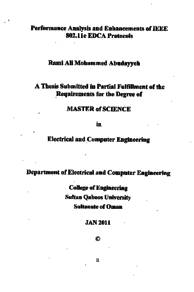وثيقة
Performance analysis and enhancement of IEEE 802.11e EDCA protocols
الناشر
Sultan Qaboos University
ميلادي
2011
اللغة
الأنجليزية
الموضوع
الملخص الإنجليزي
IEEE 802.11 wireless local area networks (WLANs) are one of the most popular and most widely deployed WLAN technologies worldwide. The explosion in the use of wireless networks has lead to increasing demands for supporting the emerging multimedia applications, e.g. VoIP and streaming video. Such applications are growing rapidly and are often characterized as bandwidth intensive and delay sensitive. This has led to the requirement that 802.11 WLANs should provide Quality-of-Service (QoS) in order to efficiently support multimedia applications. As a consequence, the IEEE 802.11é standard has been released for QoS capabilities in WLANs by introducing a contention window-based Enhanced Distributed Channel Access (EDCA) technique. Although a number of research studies have shown that EDCA is able to provide QoS support, existing EDCA techniques reset the Contention Window (CW) of a given wireless station statically after each successful transmission. This static behavior does not adapt to network state, i.e., the congestion level inside the network, which often results in poor performance and low link utilization whenever the demand for link utilization increases. Several techniques that are based on adapting CW to network conditions have been suggested to enhance the performance of IEEE 802.1le. The first part of this thesis analyzes the differentiation capabilities of the important EDCA QoS parameters by means of throughput analysis in ad hoc WLANs. The main aim of such an analysis is to gain an insight into how the QoS parameters can be best applied to support QoS requirements. The second part of this thesis implements a number of enhancement schemes, notably Simple Static Slow Decrease (SSD), Collision Rate-based Adaptive EDCF (CR-EDCF) and Simple Recursive Enhanced DCF (SR-EDCF), that have been proposed for EDCF in OPNET, a popular simulation software for wireless networks, based on the original 802.11e model. The resulting simulation model is then used to conduct a performance comparison of the enhancements schemes, as well as the original standard scheme. Our results will show that SSD outperforms the other enhancement schemes and EDCF while maintaining relatively low complexity requirements. The last part of the research proposes an enhancement to improve the performance of EDCF by tuning EDCA QoS parameters. Our simulation results will demonstrates the effectiveness of the proposed enhanced SSD scheme (E-SSD) in providing high performance compared to SSD and the other enhancement schemes.
الوصف
Thesis
المجموعة
URL المصدر
الملخص العربي
تعتبر شبكات 802 . 11 IEEE اللاسلكية واحدة من اكثر تكنلوجيا الشبكات اللاسلكية شيوعا و استخداما في العالم. ان الاستخدام الهائل للشبكات اللاسلكية ادى الى حاجة متزايدة لدعم التطبيقات متعددة الوسائط Multimedia Applications كتطبيق VoIP و تطبيق الفيديو المتدفق Video Streaming. هذه التطبيقات ، والتي تصنف على انها مستهلكة شديدة لنطاق التراسل Bandwidth و حساسة للتأخير Delay، تنمو بشكل سريع. مما ادى الى الحاجة لدعم هذه التطبيقات بجودة الخدمة QoS في شبكات 802 . 11 IEEE اللاسلكية. نتيجة لذلك تم اصدار المقياس العالمي IEEE 802 . 11e لتقديم جودة الخدمة من خلال تقنية EDCA بالرغم من أن بعض الدراسات أظهرت أن بروتوكول EDCA قادر على توفير و دعم QoS، الا أن بروتوكول EDCA يقوم بالتعامل مع قيمة عدد التنافس CW للجهاز اللاسلكي بطريقة ثابتة بعد كل عملية ارسال ناجحة. هذه الطريقة من التعامل الثابت لا تتكيف مع حالة الشبكة والتي هي مستوى الازدحام داخل الشبكة، حيث ينتج عنه اداء هزيل و افادة متدنية من خط الاتصال في حالة ازدياد الطلب على استخدام خط الاتصال. لذلك تم اقتراح عدة تقنيات لتحسين أداء مقياس IEEE 802 . 11e باعتماد التكيف مع حالة الشبكة. ان الجزء الأول من هذه الأطروحة يحلل قدرات التمييز لأهم العوامل المتغيرة Parameters الخاصة بتقنية EDCA من خلال تحليل كمية البيانات المنقولة بوحدة الزمن Throughout. الهدف الرئيس من هذه الدراسة هو الكشف عن الطريقة الأفضل لتطبيق عوامل جودة الخدمة المتغيرة QoS Parameters لدعم احتياجات جودة الخدمة أما الجزء الثاني من هذا العمل البحثي فهو بناء وتنفيذ التقنيات المقترحة لتحسين أداء EDCF و هي Simple Static Slow Decrease (SSD) Collision Rate-based Adaptive EDCF (CR-EDCF) (Simple Recursive Enhanced DCF ( SR - EDCF باستخدام نظام المحاكاة للشبكات اللاسلكية OPNET بناءا على النموذج الاصلي802 . 1le . سيتم استخدام النماذج الناتجة عن عملية البناء في اجراء دراسة مقارنه الأداء هذه التقنيات بين بعضها البعض بالاضافة الى التقنية الاصلية EDCF. نتائج الدراسة سوف تظهر أن تقنية SSD تتفوق بالأداء على EDCF و باقي التقنيات مع الأخذ بعين الاعتبار أنها تحافظ على متطلبات تنفيذ بسيطة نسبيا الجزء الأخير من هذا العمل البجٹي سيقدم مقترح لتحسين و تطوير اداء EDCF من خلال ضبط أحد العوامل المتغيرة لجودة الخدمة. نتائج تجارب المحاكاة سوف تظهر فعالية النموذج المطور E - SSD مقارنة مع التقنيات
قالب العنصر
الرسائل والأطروحات الجامعية

